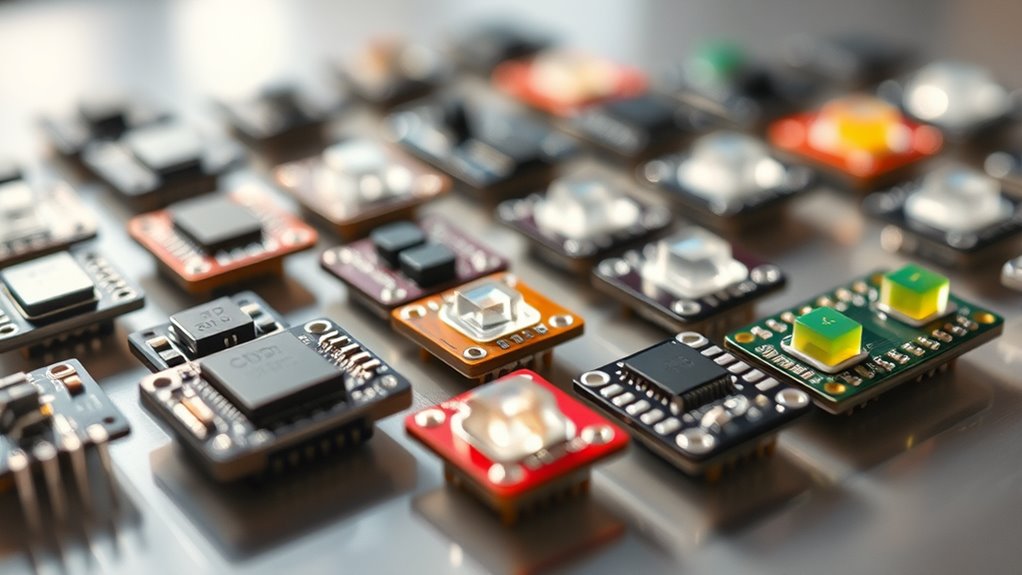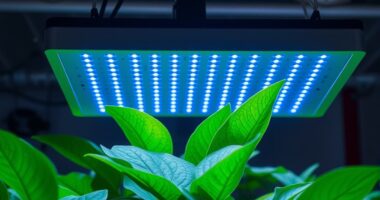If you’re looking to brighten your Arduino projects, I recommend exploring the top light sensor modules like the VEML7700, BH1750FVI, and GY-302, which offer high accuracy and easy integration via I2C. These modules range from compact photodiodes to advanced ambient light sensors suitable for automatic lighting and environment monitoring. They’re reliable and simple to use, making your setup seamless. Keep going to discover the best options and how each can enhance your project’s performance.
Key Takeaways
- High-precision sensors like VEML7700 and BH1750 provide accurate ambient light measurements for refined project control.
- Modules support easy I2C integration with Arduino, simplifying wiring and setup for various light detection applications.
- Compact sizes and adjustable thresholds make these sensors ideal for space-constrained or automation projects.
- Wide measurement ranges (up to 120,000 lux) cover indoor and outdoor lighting conditions effectively.
- Versatile options include digital, analog, and photodiode sensors suitable for diverse lighting automation needs.
Teyleten Light Dependent Resistor Sensor Module (10PCS)
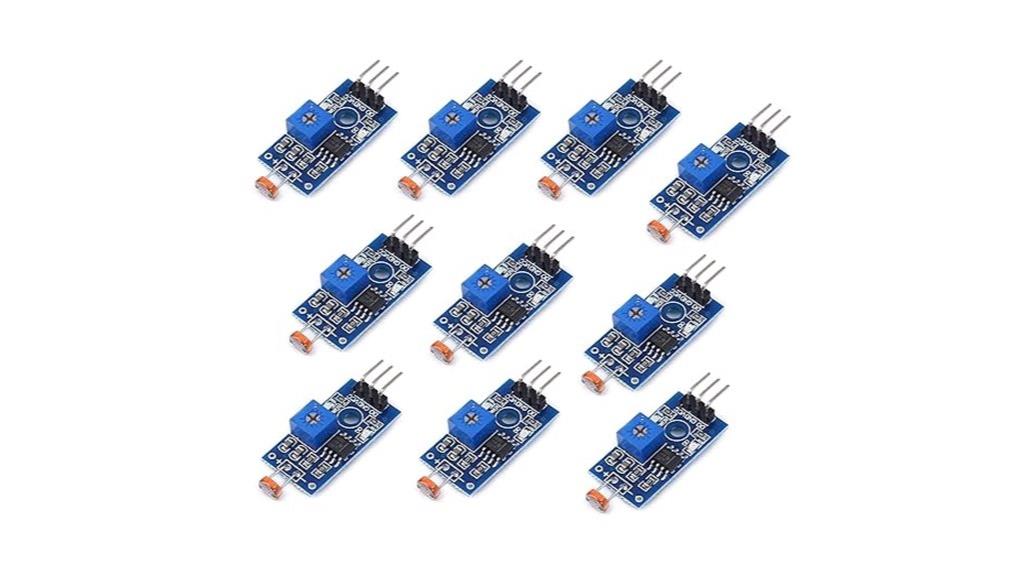
If you’re looking for an easy-to-use light detection solution suitable for various Arduino projects, the Teyleten Light Dependent Resistor Sensor Module is an excellent choice. Each package includes 10 compact modules that detect ambient light brightness and trigger microcontrollers or relays. They feature sensitive photoresistors with clean, strong signals and adjustable thresholds, making them versatile for environment monitoring, light-operated switches, or intelligent car lighting. Operating on 3.3V-5V, they’re lightweight and easy to install thanks to fixed bolt holes. Their simple digital output makes integrating them into your projects straightforward, providing reliable front light detection for various applications.
Best For: hobbyists, students, and DIY electronics enthusiasts seeking reliable, easy-to-use ambient light detection modules for Arduino and automation projects.
Pros:
- Compact and lightweight design for easy integration into various projects
- Adjustable threshold for sensitive and customizable light detection
- Strong drive capacity (>15mA) ensures reliable signal output and easy microcontroller connection
Cons:
- Only provides digital high/low signals without analog output for varying light levels
- Requires proper calibration for precise threshold setting in different environments
- Sensitive primarily to ambient light, which may limit effectiveness in highly variable lighting conditions
5PCS Photodiode Light Sensor Switch Module for Arduino and Raspberry Pi
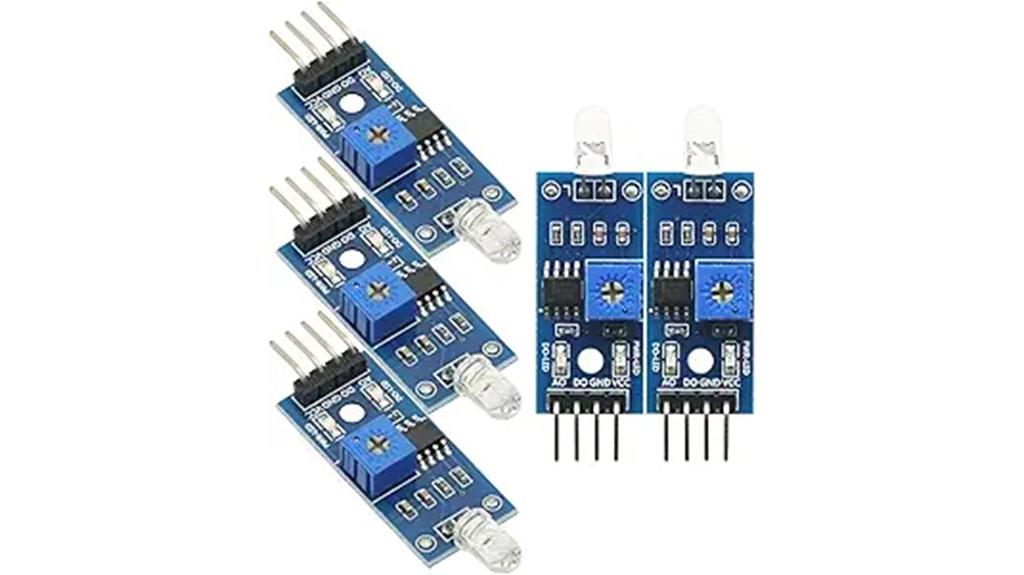
The PCS Photodiode Light Sensor Switch Module is an excellent choice for anyone seeking precise directional light detection in their Arduino or Raspberry Pi projects. Its small size and fixed bolt hole make installation straightforward, and the sensitivity is adjustable via a blue digital potentiometer. It detects ambient light brightness and intensity, perceiving the fixed light source in a specific direction, offering more accuracy than traditional photoresistors. With a digital output that switches states based on a set threshold, it can directly control relays or other devices. Suitable for automation, security, and environmental monitoring, this module provides reliable, directional light sensing in a compact form.
Best For: hobbyists, DIY enthusiasts, and engineers seeking precise directional light detection for automation, security, or environmental monitoring projects using Arduino or Raspberry Pi.
Pros:
- Small PCB size with fixed bolt hole for easy and versatile installation
- Adjustable sensitivity allows for precise light level detection
- Directional sensing capability offers more accuracy than traditional photoresistors
Cons:
- Requires basic understanding of electronics and microcontroller integration
- Limited to detecting ambient light from a fixed direction, not suitable for broad or multi-directional sensing
- Operating voltage range (3.3V-5V) may necessitate level shifting if used with certain microcontrollers
HiLetgo VEML7700 Ambient Light Sensor Module (2pcs, I2C, 16-bit, Light Environment Sensor)
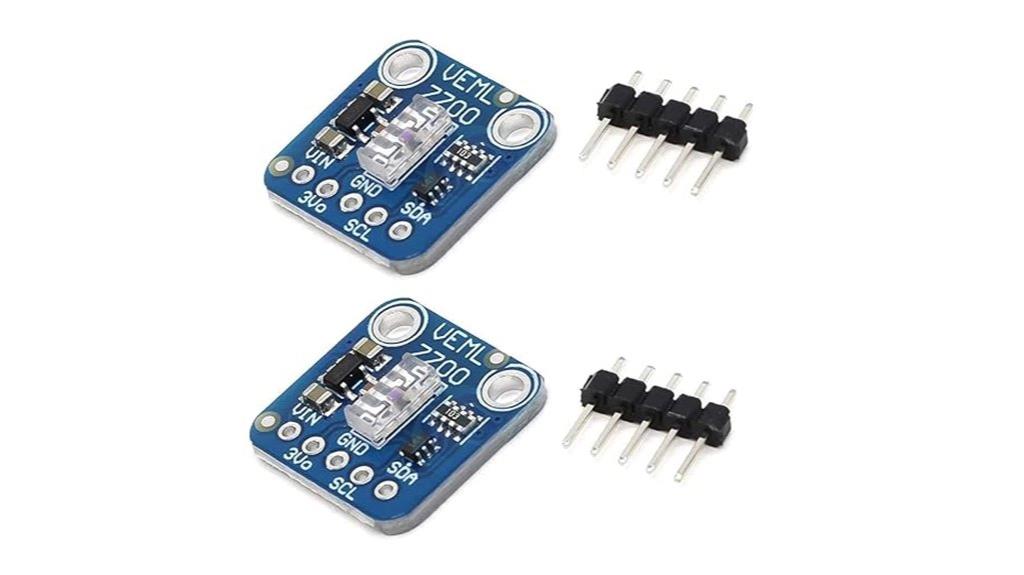
For anyone seeking precise ambient light measurements with a simple setup, the HiLetgo VEML7700 Ambient Light Sensor Modules stand out as an excellent choice. These two-pack modules use I2C communication and are compatible with Arduino and Raspberry Pi, simplifying integration. They feature a high-resolution 16-bit sensor capable of measuring from 0 to 120,000 lux with exceptional accuracy of 0.0036 lux per count. Compact and versatile, they operate on 3.3V or 5V power supplies, making them suitable for various projects. With reliable performance and solid library support, these modules are a cost-effective solution for ambient light sensing.
Best For: hobbyists and developers seeking an accurate, easy-to-integrate ambient light sensor for microcontroller projects like Arduino and Raspberry Pi.
Pros:
- High-resolution 16-bit measurement with a wide range up to 120,000 lux
- Compatible with popular platforms and supports CircuitPython libraries for easy integration
- Compact size and flexible power options (3.3V or 5V) make it versatile for various projects
Cons:
- Requires soldering of the 5-pin connector during setup, which may be challenging for beginners
- Dependence on external libraries for operation; setup can be complex for some users
- Some reports of hardware issues, such as damage or failure, necessitating careful handling
HiLetgo BH1750FVI Digital Light Illumination Sensor Module (2pcs)
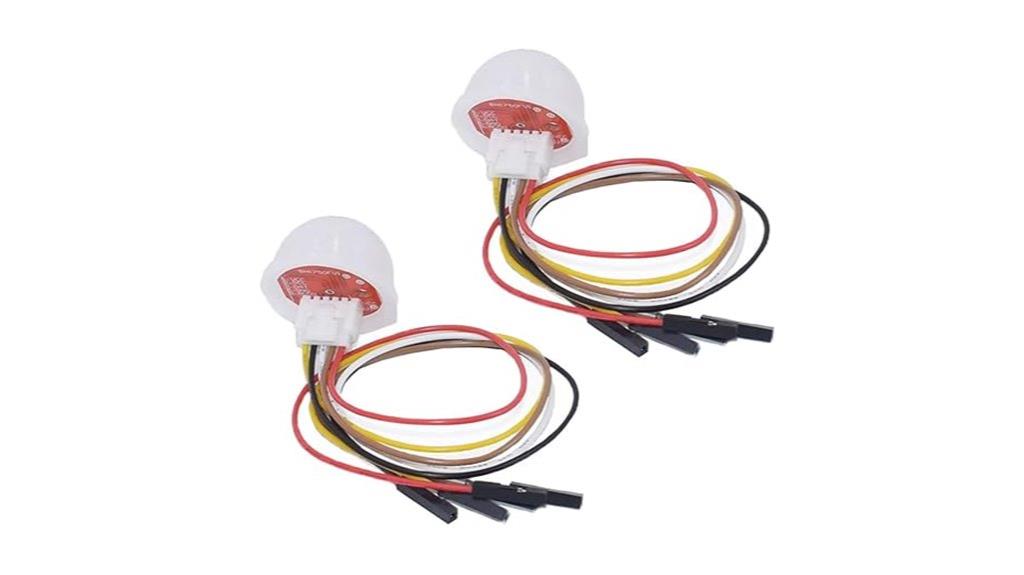
The HiLetgo BH1750FVI Digital Light Illumination Sensor Module is an excellent choice for DIY enthusiasts and hobbyists seeking precise ambient light measurement. With two units included, it’s perfect for projects requiring multiple sensors. Designed for indoor use, it detects light levels from 1 to 65,535 lux, making it versatile for applications like adjusting LCD backlights, keyboard illumination, or greenhouse lighting. It connects via I2C at 5V, compatible with Arduino, STM32, and 51 microcontrollers. Its small size and included wiring cable make integration simple. Overall, this module offers accurate, wide-range light detection for various creative lighting projects.
Best For: DIY enthusiasts, hobbyists, and developers seeking accurate ambient light measurement for indoor lighting and automation projects.
Pros:
- Precise measurement range from 1 to 65,535 lux for versatile light detection
- Compatible with popular microcontrollers like Arduino, STM32, and 51 series
- Small size with included wiring cable simplifies integration into various projects
Cons:
- Designed primarily for indoor use; may not perform well outdoors under direct sunlight
- Requires understanding of I2C communication for proper setup and use
- Limited to 5V operating voltage, which may need additional power considerations for some systems
HiLetgo GY-302 BH1750 Light Intensity Illumination Module (3pcs)
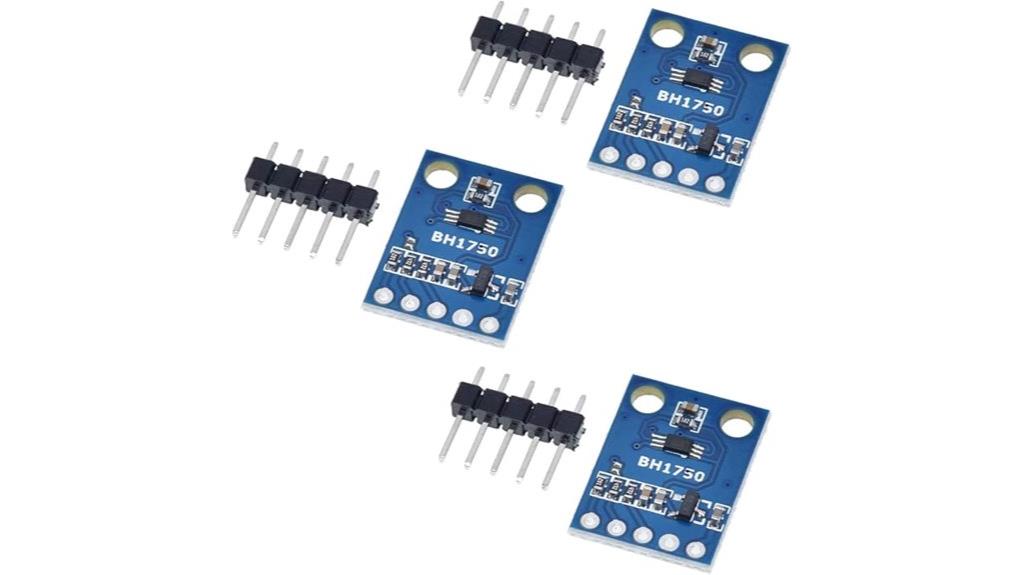
If you’re working on an Arduino project that requires precise and reliable light measurement, the HiLetgo GY-302 BH1750 Light Intensity Illumination Modules are an excellent choice. This set includes three compact modules, each measuring about 13.9mm x 18.5mm, with the trusted BH1750FVI chip from ROHM. They operate on 3-5V power and provide high-precision lux readings through a built-in 16-bit ADC, offering a wide measurement range. The modules deliver accurate digital light intensity data aligned with human visual sensitivity, all without complex calibration. Their simple PCB mount and copper design make them easy to integrate into various electronic projects.
Best For: DIY electronics enthusiasts and Arduino hobbyists needing accurate, easy-to-integrate light measurement modules for their projects.
Pros:
- High-precision digital lux measurement with 16-bit ADC for accurate readings
- Compact size (13.9mm x 18.5mm) and easy PCB mounting for versatile applications
- No calibration required, spectral response closely matches human visual sensitivity
Cons:
- Does not differentiate between types of ambient light (e.g., sunlight vs. artificial light)
- Limited to digital light intensity measurement without additional sensor features
- Requires a 3-5V power supply, which may need regulation in some projects
Digital Light Sensor for Arduino, ESP32, ESP8266, Raspberry Pi, 4 Pieces
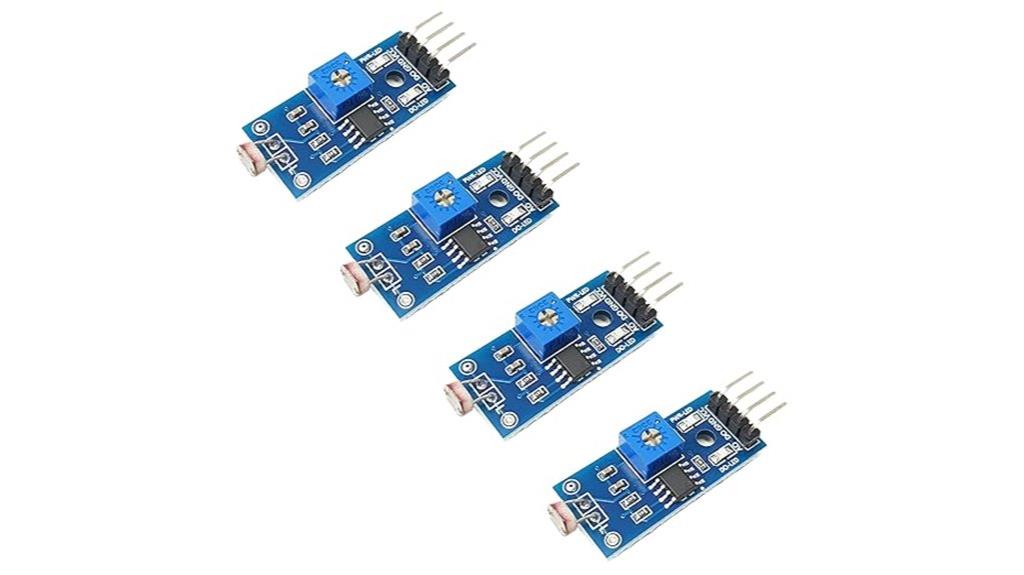
A digital light sensor module set is an excellent choice for anyone working on projects that require precise ambient light detection, especially when using microcontrollers like Arduino, ESP32, ESP8266, or Raspberry Pi. This pack includes four sensors with adjustable thresholds via built-in potentiometers, making it easy to customize sensitivity. They feature both digital and analog outputs, allowing for flexible integration into various setups. Operating at 3.3V to 5V, these sensors detect light levels and trigger digital signals when thresholds are crossed. Perfect for automation, lighting control, or environmental monitoring, they simplify light sensing tasks across multiple projects.
Best For: DIY electronics enthusiasts, educators, and developers seeking reliable ambient light sensing solutions for automation, robotics, or environmental monitoring projects.
Pros:
- Includes four sensors for multi-point light detection and testing
- Adjustable threshold via built-in potentiometers for customizable sensitivity
- Compatible with a wide range of microcontrollers including Arduino, ESP32, ESP8266, and Raspberry Pi
Cons:
- Requires basic understanding of electronics and microcontroller integration
- Analog output may need additional circuitry for precise readings in some applications
- Sensitivity adjustment may need fine-tuning for specific environments
5Pcs TEMT6000 Ambient Light Sensor Modules for Arduino Light Detection
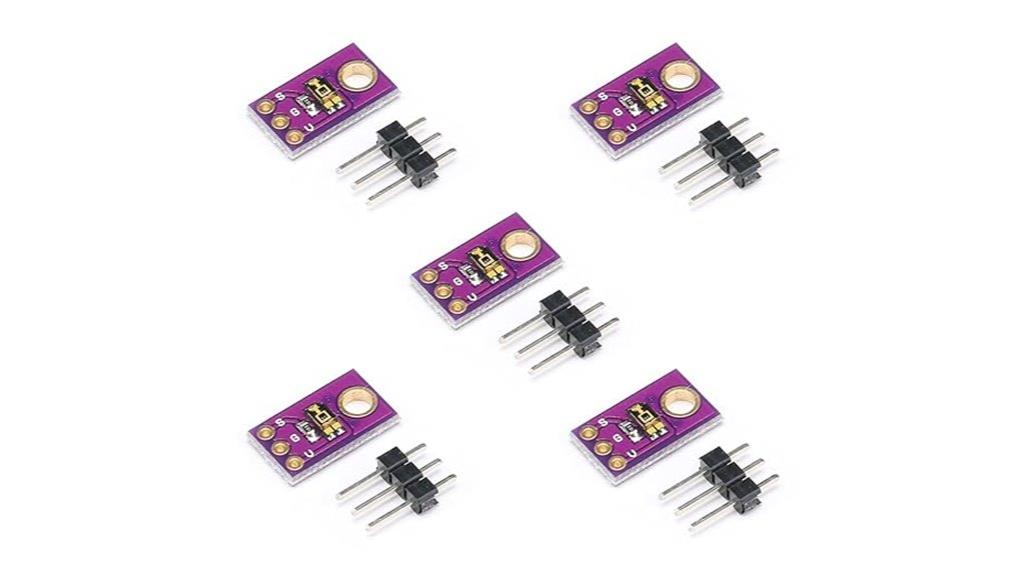
These 5-piece TEMT6000 ambient light sensor modules are ideal for Arduino users seeking accurate and responsive light detection. They mimic the human eye’s response to visible light, providing linear output without extra filtering, which guarantees precise measurements. With a detection range of 1 to 1000 Lux, they’re perfect for controlling lighting, screens, or other devices based on ambient light levels. Operating smoothly between 3.3V and 5.5V, and tolerating temperatures from -40°C to 85°C, these modules are versatile and durable. Their analog output simplifies integration with various systems, making them a reliable choice for your smart projects.
Best For: DIY electronics enthusiasts and Arduino users looking for accurate ambient light sensing for smart home or automation projects.
Pros:
- High sensitivity mimics human eye response for natural light measurement
- Linear analog output simplifies system integration
- Wide operating voltage and temperature range for versatile applications
Cons:
- Limited detection range may not suit extremely high or low light environments
- Analog output may require additional ADC circuitry for some microcontrollers
- Sensitivity to environmental factors like dust or dirt on the sensor surface
Photodiode Sensor Module (10pcs)
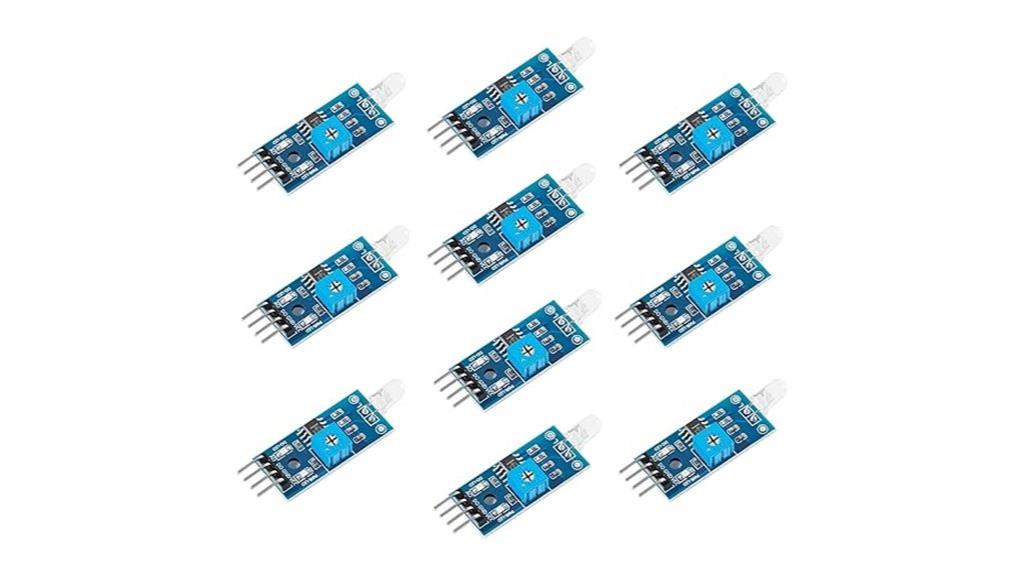
The Photodiode Sensor Module (10pcs) is an excellent choice for Arduino enthusiasts seeking precise light detection in their projects. Its 4-pin, compact design makes integration straightforward, with a 5mm size perfect for various setups. The module detects ambient light with high directional sensitivity, providing accurate readings by sensing light sources directly in front. It offers both digital (DO) and analog (AO) outputs, allowing versatile application options. Sensitivity is adjustable via a built-in blue digital potentiometer, and it operates on 3.3V-5V power. With easy wiring and mounting, this pack of 10 modules is ideal for scalable, reliable light detection projects.
Best For: Arduino hobbyists and makers seeking precise, directional light detection for their projects.
Pros:
- High directional sensitivity for accurate light source detection
- Adjustable sensitivity via built-in digital potentiometer
- Compact size with easy mounting and wiring for versatile applications
Cons:
- Requires proper calibration for consistent readings
- Limited to 3.3V-5V power supply compatibility, not suitable for lower voltage systems
- Digital output may need additional circuitry for complex integrations
WWZMDiB 6 Pcs 5MM LDR Light Sensor 5516 Photoresistor LM393 3 Pin 3.3-5V Compatible with Arduino Raspberry Pi ESP32
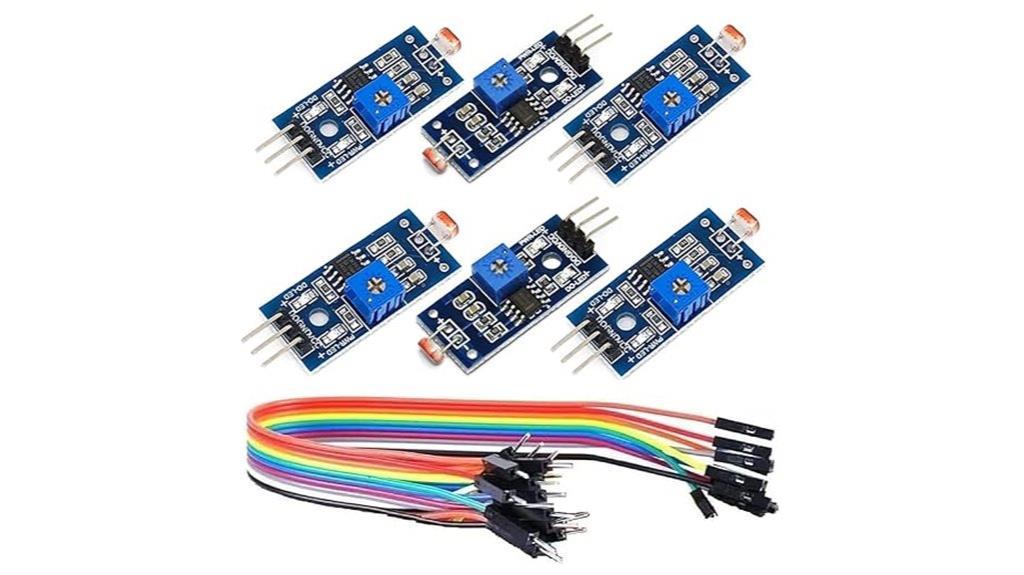
If you’re looking for an affordable and easy-to-integrate light sensing solution for your microcontroller projects, WWZMDiB’s 6-pack of 5mm LDR Light Sensors is an excellent choice. These sensors feature the 5516 photoresistor with the LM393 comparator, compatible with Arduino, Raspberry Pi, and ESP32. Operating at 3-5V, they offer both digital and optional analog outputs, making calibration straightforward through the potentiometer. Users find them easy to program, reliable, and well-built. They work effectively for ambient light detection and automatic control, with many praising their affordability and performance. Overall, these sensors are a versatile addition to any light-based project.
Best For: hobbyists and DIY electronics enthusiasts seeking an affordable, easy-to-use light sensor for microcontroller projects involving Arduino, Raspberry Pi, or ESP32.
Pros:
- Easy to integrate and calibrate with potentiometer adjustment
- Compatible with multiple microcontrollers including Arduino, Raspberry Pi, and ESP32
- Reliable performance with clear digital output and optional analog signal
Cons:
- Slight delay in light detection can occur in some cases
- Requires manual calibration for precise light threshold settings
- Limited to 3.3-5V operation, which may not suit all systems
HiLetgo 3pcs TEMT6000 Light Sensor Modules
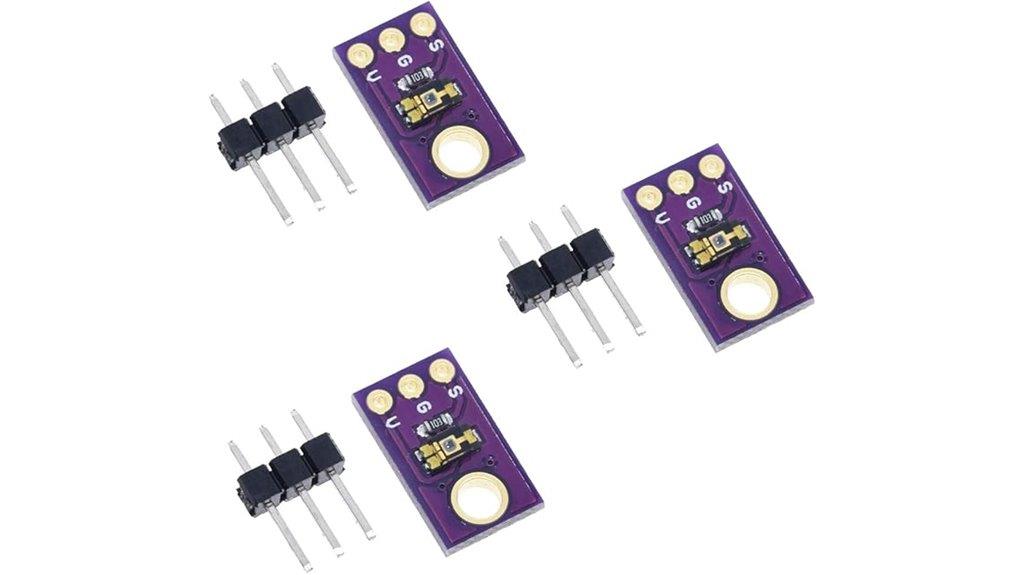
For Arduino hobbyists seeking affordable and reliable light sensing solutions, the HiLetgo 3pcs TEMT6000 Light Sensor Modules stand out with their high sensitivity at 570nm and wide semi-sensitivity angle of ±60 degrees. Each sensor is mounted on a PCB, making installation straightforward. They require no batteries to operate, drawing power directly from your Arduino setup. With a compact design, these sensors are perfect for detecting ambient light levels in various projects. The package includes three units, giving you flexibility for multiple applications. Rated 4.2 out of 5 stars, they’re a practical choice for DIYers looking for dependable, easy-to-use light sensors.
Best For: DIY electronics enthusiasts and Arduino hobbyists seeking affordable, reliable ambient light sensing solutions for various projects.
Pros:
- High sensitivity at 570nm wavelength for accurate light detection
- Wide semi-sensitivity angle of ±60 degrees enhances versatility in positioning
- Easy to install on PCB without the need for batteries, simplifying setup
Cons:
- Limited to ambient light detection; not suitable for precise or specialized light measurements
- No included batteries or integrated power source, requiring connection to a microcontroller
- Moderate customer ratings (4.2/5) suggest some users may experience variability in performance
12Pcs Photoresistor Light Sensor 3Pin 3.3V-5V 5MM LDR LM393 for Arduino
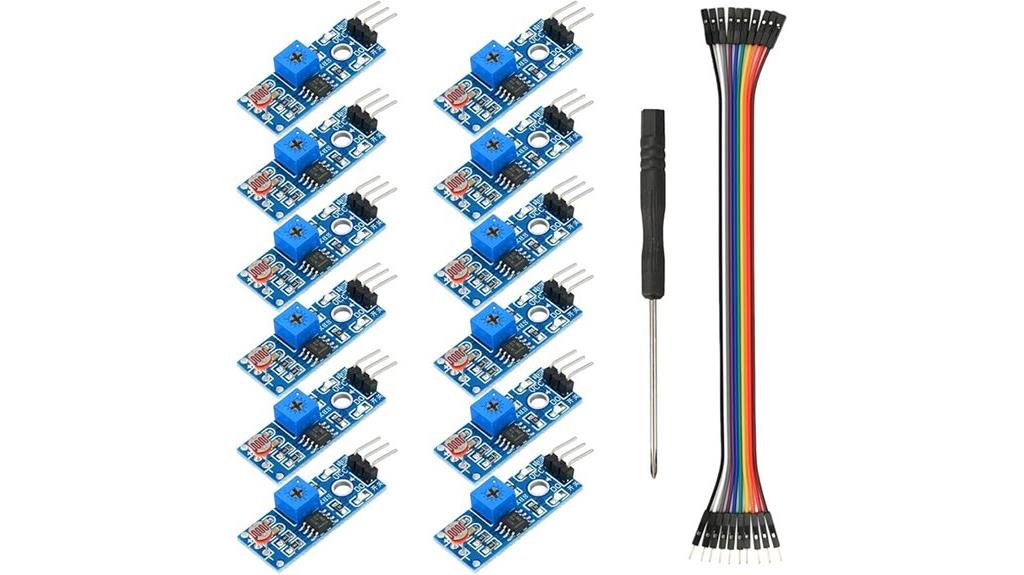
Designed for hobbyists and developers working on light-sensitive projects, the Pcs Photoresistor Light Sensor 3Pin 3.3V-5V 5MM LDR LM393 offers dependable ambient light detection. This set includes 12 sensors with a 3-pin configuration compatible with Arduino, supporting both digital and analog detection. Its compact size (32×14mm) and wide operating voltage (3.3V-5V) make it versatile for various applications. The LM393 comparator ensures a clean, strong output signal that can drive relays or microcontrollers directly. With adjustable sensitivity via a potentiometer, it adapts well to different lighting conditions, perfect for automation, light control, and monitoring projects.
Best For: hobbyists and developers seeking reliable, adjustable light sensors for automation, light control, or ambient light monitoring projects with Arduino compatibility.
Pros:
- Compatible with Arduino and supports both digital and analog light detection.
- Adjustable sensitivity via potentiometer for versatile lighting conditions.
- Strong output signal capable of directly driving relays or microcontrollers.
Cons:
- Requires proper wiring and calibration for optimal performance.
- Limited to 5mm LDR size, which may not suit all installation spaces.
- Potential sensitivity to ambient noise or electrical interference without proper shielding.
2 Pcs 16-bit I2C Interface VEML7700 Ambient Light Sensor Module for Arduino

The Pcs 16-bit I2C Interface VEML7700 Ambient Light Sensor Modules are an excellent choice for Arduino enthusiasts seeking high-precision ambient light measurement in compact form. These modules measure light levels from 0 to 120,000 lux with a resolution of 16 bits and an accuracy of 0.0036 lux per count. The I2C interface with a fixed address 0x10 makes integration straightforward, and the modules operate on 3.3 or 5 V power supplies. Their small size, approximately 17 x 17 x 4 mm, allows easy installation in tight spaces. Soldering of the included connector is required, but setup is simple, providing reliable, precise light sensing for any project.
Best For: Arduino hobbyists and developers seeking high-precision ambient light sensing in compact, easy-to-integrate modules.
Pros:
- Provides highly accurate measurements with 0.0036 lux per count resolution.
- Compact size (17 x 17 x 4 mm) ideal for tight spaces and portable projects.
- Simple I2C interface with fixed address 0x10 for straightforward integration.
Cons:
- Requires soldering of the included connector, which may be challenging for beginners.
- Compatible only with 3.3 V or 5 V power supplies, limiting flexibility with other voltage levels.
- Limited to ambient light measurement; not suitable for other environmental sensing needs.
3pcs BH1750 Light Sensor Module for Arduino
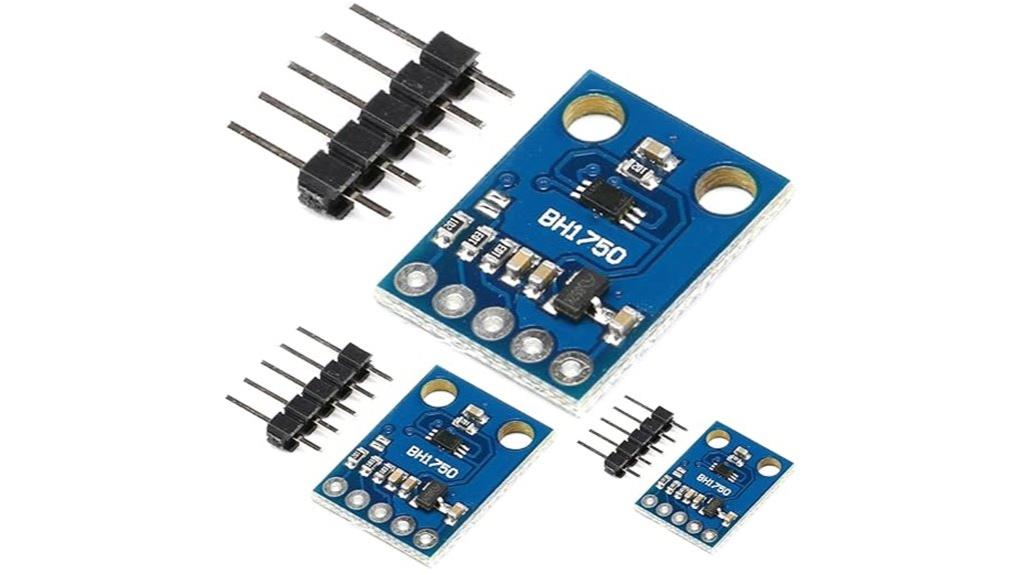
If you’re looking for a reliable and easy-to-integrate light sensing solution for your Arduino projects, the 3pcs BH1750 Light Sensor Module is an excellent choice. It offers high-precision measurements from 0 to 65,535 lux, making it suitable for photography, agriculture, and smart lighting. Its spectral sensitivity closely matches human eye response, ensuring accurate ambient light detection. The module uses the trusted ROHM BH1750FVI chip for consistent readings and features a digital output that simplifies integration without complex calibration. Compact at just 13.9mm x 18.5mm, it’s versatile, compatible with various microcontrollers, and perfect for projects that demand precise light measurement.
Best For: hobbyists and professionals seeking an easy-to-integrate, high-precision ambient light sensor for Arduino, Raspberry Pi, or similar microcontroller projects.
Pros:
- Provides accurate light measurement from 0 to 65,535 lux, suitable for various applications.
- Uses the reliable ROHM BH1750FVI chip for consistent and stable readings.
- Compact size (13.9mm x 18.5mm) allows seamless integration into space-constrained projects.
Cons:
- Requires 3 to 5 volts power supply, which may need voltage regulation in some setups.
- Digital output may require additional programming for data interpretation.
- Not suitable for extreme environmental conditions without additional protective measures.
SHILLEHTEK GY-302 Light Intensity I2C Module for Raspberry Pi and Microcontrollers
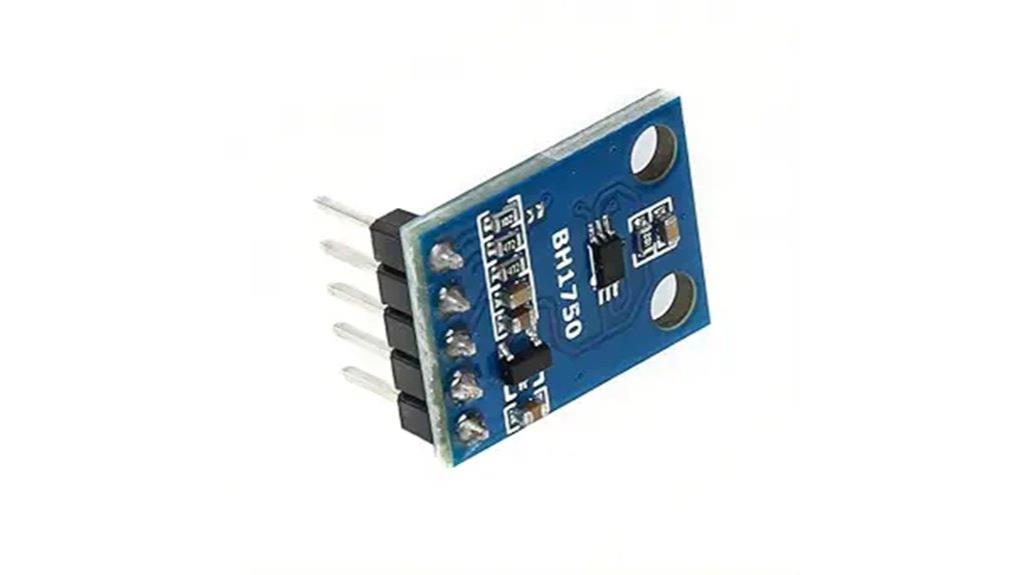
For those seeking accurate and easy-to-integrate light measurement, the SHILLEHTEK GY-302 Light Intensity I2C Module is an excellent choice. It delivers high-accuracy lux readings with a digital output, so you don’t need to worry about complex calculations or calibration. The module comes pre-soldered with pins, making installation quick and solderless. Compatible with Raspberry Pi, Arduino, ESP32, and other microcontrollers, it’s versatile for various projects. Offering both High-Resolution and Low-Resolution modes, it adapts to different lighting conditions. Whether for ambient light monitoring or smart lighting, this sensor provides reliable, precise data effortlessly.
Best For: hobbyists, students, and professionals seeking accurate, easy-to-use light measurement solutions for various microcontroller projects.
Pros:
- High-accuracy digital lux readings with minimal calibration needed
- Compatible with multiple platforms including Raspberry Pi, Arduino, and ESP32
- Solderless, quick installation with pre-soldered pins
Cons:
- Limited to light intensity measurement, not suitable for other environmental sensors
- Requires I2C communication setup, which may be challenging for complete beginners
- May need additional calibration for ultra-precise applications
2 Pcs BH1750 Digital Light Intensity Light Modules for Arduino
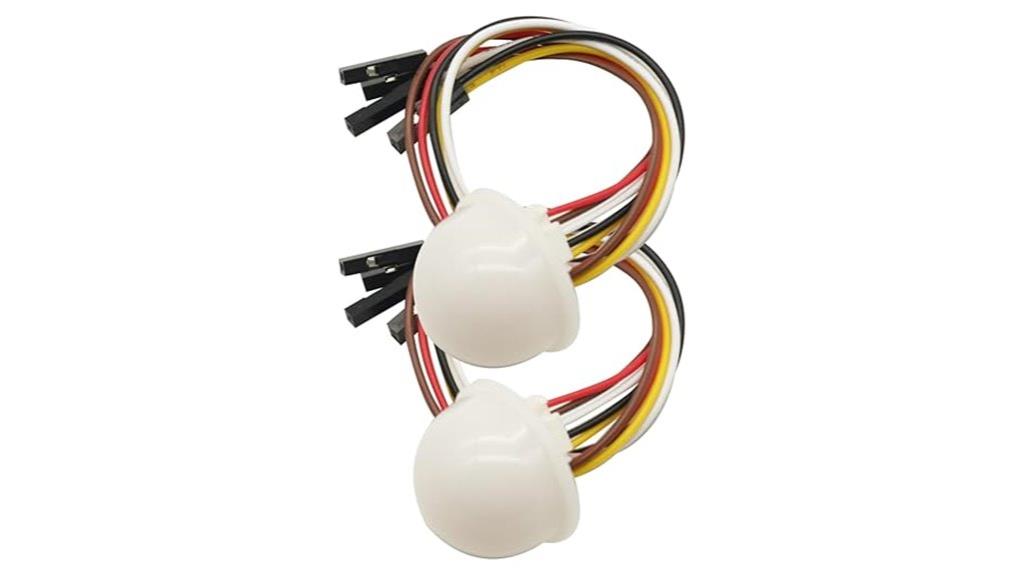
With their compact design and accurate light measurement capabilities, the Pcs BH1750 Digital Light Intensity Modules are ideal for Arduino projects that require precise ambient light sensing. These modules include two units with light balls, making them easy to deploy in various setups. Operating at 5V and utilizing I2C communication, they measure a wide light range from 1 to 65,535 lux, with a spectral sensitivity peak at 560nm. They’re perfect for automatic brightness adjustments of displays or keyboards, providing reliable data for responsive lighting control. Their small size and integrated sensor make them versatile, straightforward, and suitable for many illumination sensing applications.
Best For: hobbyists, students, and engineers working on Arduino projects requiring precise ambient light sensing and automatic brightness control.
Pros:
- Compact and easy to deploy due to integrated light balls and small size.
- Wide measurement range from 1 to 65,535 lux for versatile applications.
- Simple I2C interface allows for straightforward integration with Arduino systems.
Cons:
- Requires a 5V power supply, limiting compatibility with some low-voltage platforms.
- Spectral sensitivity peak at 560nm may not cover all specific light spectrum needs.
- Limited to light intensity measurement; does not provide color or spectral data.
Factors to Consider When Choosing Arduino Light Sensor Modules
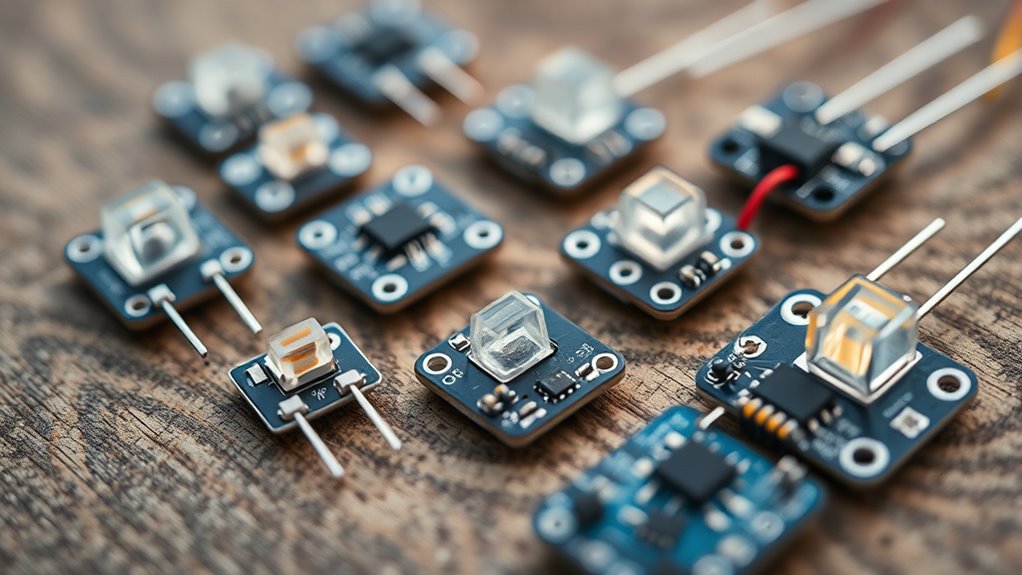
When choosing an Arduino light sensor module, I consider several key factors to guarantee it fits my project needs. These include the sensor’s sensitivity range, measurement accuracy, power requirements, signal output type, and response speed. Understanding these points helps me select the best module for reliable and efficient performance.
Sensor Sensitivity Range
The sensitivity range of an Arduino light sensor determines the span of light levels it can accurately detect, which is essential for matching the sensor to your specific application. Sensors with a broad range, like 0 to 120,000 lux, can handle various environments, from dim rooms to bright sunlight. Conversely, narrower ranges are better for indoor lighting control, where ambient light changes minimally. It’s also important to consider the sensor’s resolution, such as 16-bit, which affects its ability to detect small differences within its range. Additionally, spectral sensitivity matters because it influences how the sensor responds to different light sources and colors. Choosing the right sensitivity range guarantees your project accurately interprets light levels without unnecessary complexity or limitations.
Measurement Accuracy
How accurately a light sensor measures ambient light depends on several key factors, including its lux range and resolution. Sensors with higher bit-depth, like 16-bit modules, offer finer measurement granularity, making readings more precise. Calibration is essential; aligning the sensor’s spectral sensitivity with human vision guarantees more reliable results. Environmental conditions, such as temperature fluctuations, can also impact accuracy, so choosing sensors with built-in compensation and filtering helps maintain consistency. Digital sensors generally outperform analog or photoresistor-based options in measurement reliability because they incorporate these features. Ultimately, selecting a sensor with appropriate resolution, proper calibration, and environmental resilience will guarantee your project gets the most accurate ambient light readings possible.
Power Compatibility
Choosing a light sensor module for your Arduino project requires careful attention to power compatibility. First, confirm the sensor’s operating voltage matches your microcontroller’s voltage—whether 3.3V or 5V—to prevent damage and guarantee proper function. Check that the sensor supports your power supply range, like 3.3V-5V, which is common in Arduino, Raspberry Pi, and ESP32 boards. Powering a sensor outside its specified voltage can result in inaccurate readings, malfunction, or permanent damage. Additionally, consider the sensor’s power consumption, especially if you’re working on battery-powered or low-power projects. If your microcontroller’s voltage differs from the sensor’s, use regulators or level shifters to keep everything safe and reliable. Proper power compatibility is essential for peak sensor performance and longevity.
Signal Output Type
When selecting an Arduino light sensor module, it’s important to take into account the type of signal output it provides, as this directly affects how you’ll process the data. Some sensors offer digital outputs, which give a simple HIGH or LOW signal, ideal for basic on/off detection. These are easy to connect and require minimal signal processing. Others provide analog voltage signals, offering a continuous range proportional to light intensity, allowing for more precise measurements. Additionally, certain sensors feature adjustable thresholds or sensitivity settings, influencing the output type and quality. Understanding whether you need straightforward digital signals or detailed analog readings helps determine compatibility with your microcontroller and simplifies your project’s design. The output type ultimately impacts how complex your signal processing will need to be.
Response Speed
The response speed of an Arduino light sensor module is a critical factor that determines how quickly it can detect changes in light levels. Faster response times are essential for applications requiring real-time adjustments, like automatic lighting or tracking systems. Photodiode-based sensors typically offer microsecond response times, making them ideal for dynamic environments. In contrast, photoresistor (LDR) sensors tend to respond in hundreds of milliseconds to seconds, which may be too slow for quick reactions. Digital sensors with integrated amplifiers and ADCs usually process signals faster than analog ones, providing quicker responses. When choosing a sensor, consider your project’s need for immediate detection. Opting for quicker sensors ensures your system reacts promptly, maintaining accuracy and efficiency in changing light conditions.
Physical Size
The physical size of a light sensor module plays a crucial role in how well it fits into your project’s design, especially when space is limited. Smaller modules, around 13-18mm in length and width, are ideal for compact or wearable devices, enabling seamless integration without clutter. Larger modules might offer additional features or easier handling but can be problematic in tight enclosures or small spaces. The dimensions, including PCB size and mounting hole spacing, also influence compatibility with existing housings or mounting points. Selecting a size that aligns with your project’s spatial constraints ensures proper placement, stable mounting, and accurate light detection. Careful consideration of size helps you avoid fitment issues and maximizes your sensor’s effectiveness in your design.
Installation Ease
Choosing an Arduino light sensor module that’s easy to install can save you time and prevent frustration during setup. Look for modules with clearly marked, accessible mounting holes or brackets—they make attachment straightforward. Opt for compact, lightweight sensors (under 5 grams) to simplify mounting in tight or delicate spaces. Modules with pre-soldered connectors or simple wiring options reduce the complexity of setup, especially if you’re new to electronics. Clear documentation on wiring, power needs, and installation procedures is vital to minimize errors. Additionally, sensors with built-in mounting features or compatible accessories can streamline securing the module in place. Prioritizing ease of installation ensures a smoother project build and lets you focus more on functionality rather than troubleshooting setup issues.
Cost and Budget
Arduino light sensor modules come in a wide price range, making it essential to evaluate your project’s needs against your budget. Basic photoresistors can cost less than $1, which is perfect for simple applications, but they lack precision. More advanced digital sensors with features like I2C communication can cost over $20, offering higher accuracy and reliability. If you’re working with tight budgets, you might opt for cheaper analog sensors, though they may require calibration and have limited sensitivity. Investing in higher-quality modules can reduce calibration efforts and improve measurement stability, but it increases costs. Ultimately, balancing your project’s performance requirements with your budget helps you choose a sensor that’s both effective and economical.
Frequently Asked Questions
Which Sensor Offers the Highest Accuracy for Ambient Light Measurement?
The TSL2591 sensor offers the highest accuracy for ambient light measurement. I’ve used it in projects where precise light readings were essential, and it performed exceptionally well. Its high dynamic range and ability to distinguish different light spectra make it stand out. I recommend it if you need reliable, detailed ambient light data, especially for applications requiring fine sensitivity and accuracy.
Are These Sensors Compatible With All Arduino and Raspberry Pi Models?
Think of these sensors as versatile chameleons—they adapt well across various platforms. Most Arduino light sensors are compatible with many Arduino models, especially the common Uno, Mega, and Nano. Raspberry Pi compatibility depends on the sensor type; many use I2C or analog inputs, which Pi can handle with adapters. Always check the sensor’s datasheet to guarantee it plays nicely with your specific model, but generally, they’re quite adaptable.
What Is the Typical Power Consumption of These Light Sensor Modules?
Typically, these light sensor modules consume very little power, usually around 1 to 20 milliamps depending on the model and operating voltage. I find this low power usage ideal for battery-powered projects, as it helps conserve energy while still providing reliable light detection. When designing your project, always check the specific datasheet for exact consumption figures, but overall, these sensors are quite energy-efficient and won’t drain your power source quickly.
How Do Environmental Factors Affect Sensor Performance?
Environmental factors are like unpredictable weather, shaping how sensors perform. Brightness can be drowned out by shadows or reflections, causing inconsistent readings. Dirt, dust, and humidity cling to the sensor’s surface, dulling its sensitivity. Sudden temperature shifts can skew results, while electrical noise from nearby devices creates static. I keep my sensors shielded and calibrated, understanding that the environment’s whims can either amplify or mute their light-detecting prowess.
Can These Sensors Be Integrated With Existing Home Automation Systems?
Yes, these sensors can be integrated with existing home automation systems. I connect them to microcontrollers like Arduino or Raspberry Pi, then link these to your smart home hub via Wi-Fi or Zigbee. This setup allows you to automate lighting based on ambient light levels easily. I recommend checking compatibility and using appropriate interfaces to guarantee smooth integration and reliable performance in your smart home environment.
Conclusion
So, now that you’ve seen my top picks, the real question is—are you ready to take your projects to the next level? These sensors hold the key to revealing new possibilities and creating smarter, brighter designs. But which one will you choose? The perfect sensor could be waiting just around the corner, ready to transform your ideas into reality. Don’t wait too long—your innovative project is calling.
